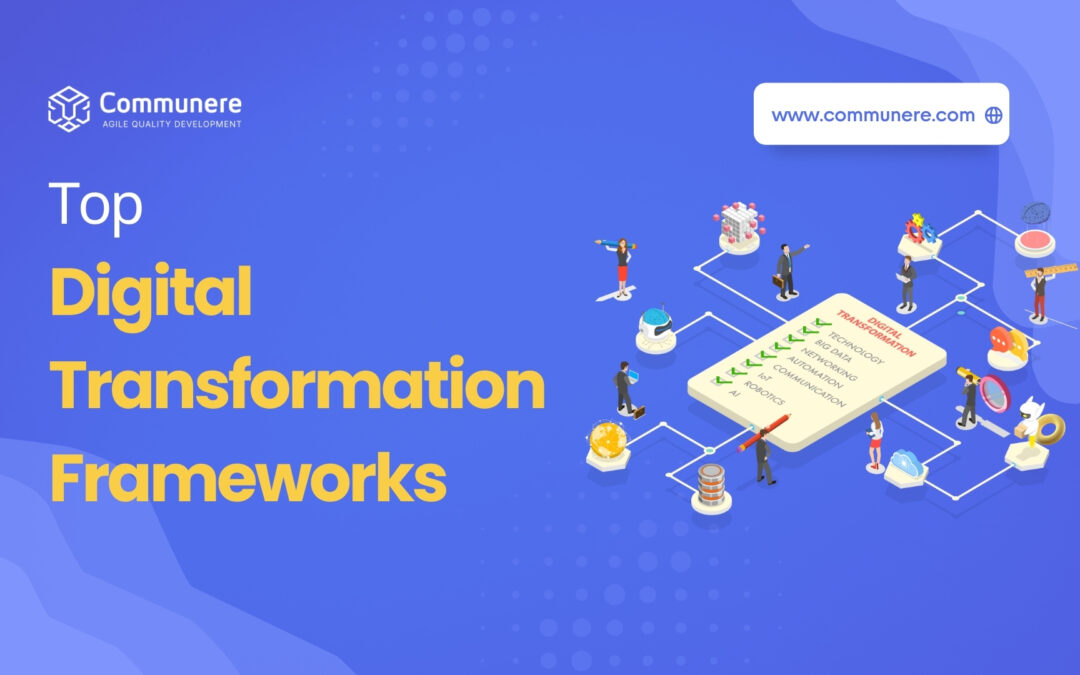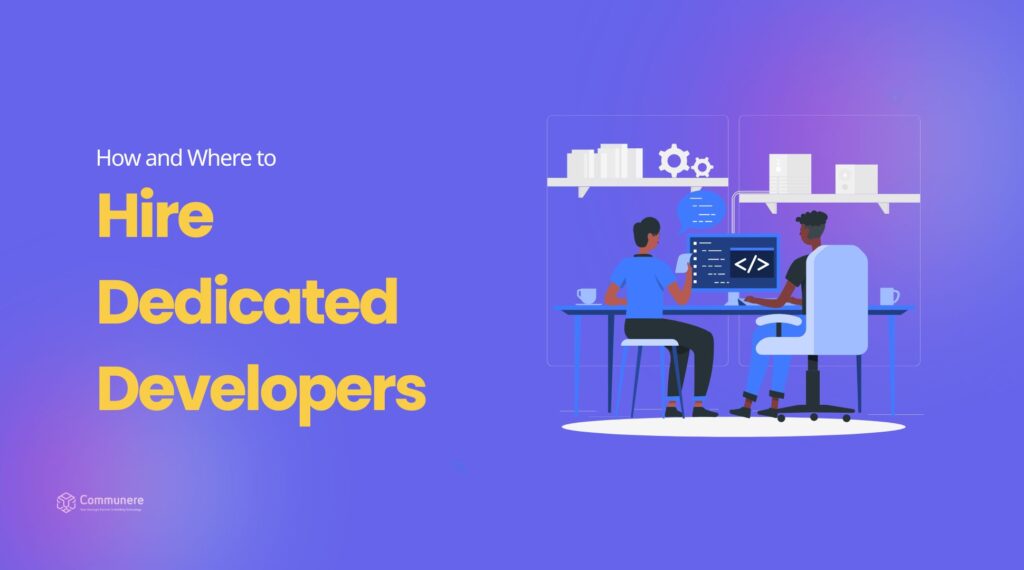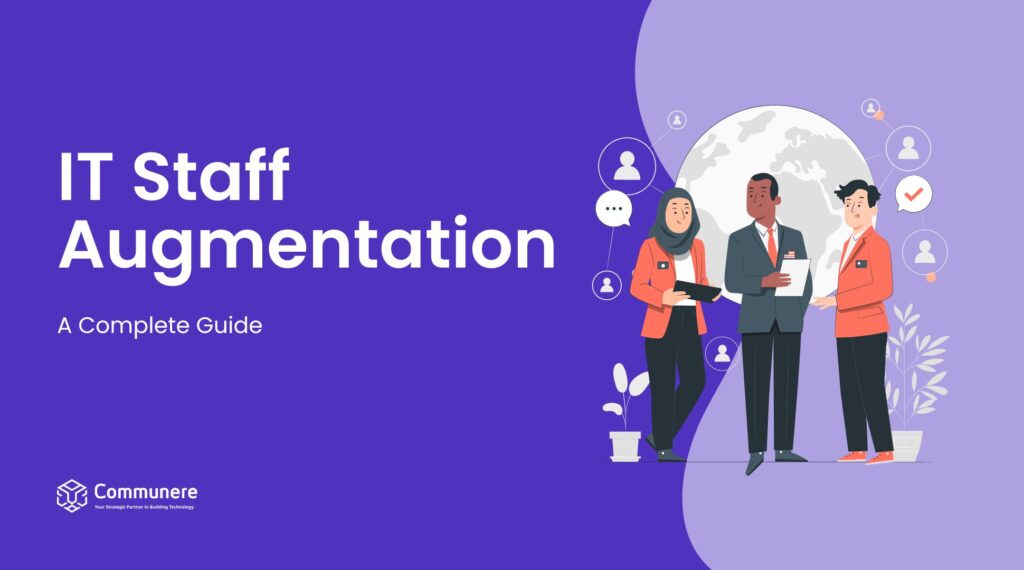Digital transformation has become a buzzword in contemporary times, signifying the integration of digital technologies into all aspects of an organisation. In this dynamic environment, various frameworks have emerged to guide businesses through this transformative journey. These frameworks provide structured approaches to align strategies, processes, and people with the digital age. In this exploration, we’ll delve into ten popular digital transformation frameworks, each offering a unique perspective on navigating the complexities of modern business evolution.
Before we explore the frameworks, let’s establish a common understanding of digital transformation. At its core, digital transformation involves leveraging digital technologies to enhance business processes, improve customer experiences, and drive innovation. It’s a holistic approach that goes beyond simply adopting new technologies; it encompasses a cultural shift, strategic alignment, and the development of digital capabilities.
Digital transformation is not just an option; it’s a necessity for survival and growth. The Fourth Industrial Revolution has ushered in unprecedented changes, demanding organisations to be agile, adaptive, and tech-savvy. Embracing digital transformation enables businesses to stay competitive, respond to market changes swiftly, and meet evolving customer expectations.
Table of Contents
- 10 Popular Digital Transformation Frameworks
- McKinsey 7S Digital Transformation Framework:
- Prosci ADKAR Digital Transformation Framework:
- TOGAF Digital Transformation Framework:
- ITIL Digital Transformation Framework:
- Capgemini Digital Transformation Framework:
- Deloitte Digital Transformation Framework
- Gartner Digital Transformation Framework
- MIT Digital Transformation Framework
- Accenture Digital Transformation Framework
- BCG Digital Transformation Framework
- 5 Key Components of a Digital Transformation Framework
- 4 Steps to Implementing a Digital Transformation Framework
- Digital Transformation Framework FAQs
- Digital Transformation Framework: A Recap
10 Popular Digital Transformation Frameworks
Digital transformation frameworks serve as guiding tools, offering a roadmap for organisations to navigate the complexities of change. These frameworks address various aspects, including strategy, culture, technology, and customer engagement. Let’s explore ten popular frameworks in detail.
McKinsey 7S Digital Transformation Framework:
The McKinsey 7S framework, developed by the renowned consulting firm McKinsey & Company, focuses on seven key elements: strategy, structure, systems, shared values, style, staff, and skills. The framework emphasises the interconnectedness of these elements, underscoring the need for alignment to achieve successful digital transformation.
- Strategy: The overarching plan for digital transformation.
- Structure: The organisational design that facilitates digital initiatives.
- Systems: The technological infrastructure supporting digital processes.
- Shared Values: The core beliefs that guide the organisation’s digital journey.
- Style: Leadership approach and organisational culture in the digital context.
- Staff: Human resources and talent management for digital capabilities.
- Skills: The competencies required for successful digital implementation.
The strength of the McKinsey 7S framework lies in its holistic view, acknowledging that these elements are interdependent. Successful digital transformation requires a careful balance and integration of these components and how they need to align for successful digital transformation.
Prosci ADKAR Digital Transformation Framework:
Originally designed for change management, the Prosci ADKAR model – Awareness, Desire, Knowledge, Ability, Reinforcement – is widely adopted in digital transformation. This model provides a structured approach to managing individual transitions, ensuring that employees are ready and able to adapt to new technologies and processes.
- Awareness: Understanding the need for digital transformation.
- Desire: Developing the motivation and commitment for the change.
- Knowledge: Acquiring the necessary information and skills.
- Ability: Applying new knowledge effectively in the digital context.
- Reinforcement: Sustaining the changes through continuous support and recognition.
The ADKAR model recognises the human factor in digital transformation, emphasising the importance of addressing individuals’ concerns and facilitating a smooth transition.
TOGAF Digital Transformation Framework:
The Open Group Architecture Framework (TOGAF) is an enterprise architecture methodology used to enhance business efficiency. TOGAF provides a comprehensive approach to designing, planning, implementing, and governing enterprise information architecture. It helps organisations align their IT strategies with overall business goals, ensuring a cohesive approach to digital transformation.
- Design: Developing a blueprint for the digital architecture.
- Planning: Strategising the implementation of digital initiatives.
- Implementation: Executing the digital transformation plan.
- Governance: Overseeing and adjusting digital processes to meet objectives.
TOGAF’s strength lies in its systematic approach to aligning IT and business strategies, fostering a more integrated and efficient digital ecosystem.
ITIL Digital Transformation Framework:
ITIL (Information Technology Infrastructure Library) is a set of practices for IT service management (ITSM) that focuses on aligning IT services with business needs. While not exclusively a digital transformation framework, ITIL is leveraged to ensure that IT processes and services support overall transformation goals.
- Service Strategy: Aligning IT services with business objectives.
- Service Design: Designing effective and efficient IT processes.
- Service Transition: Implementing changes with minimal disruption.
- Service Operation: Ensuring IT services operate effectively.
- Continuous Improvement: Iteratively improving IT services to meet evolving needs.
ITIL contributes to digital transformation by providing a structured approach to managing IT services, ensuring they evolve in sync with changing business requirements.
Capgemini Digital Transformation Framework:
Capgemini, a global consulting and technology services firm, has developed its digital transformation framework. This model typically includes stages such as ideation, proof of concept, pilot, and scale, emphasising a customer-centric approach to digital transformation.
- Ideation: Generating and exploring innovative digital ideas.
- Proof of Concept: Validating the feasibility of digital initiatives.
- Pilot: Testing digital solutions on a smaller scale.
- Scale: Implementing and expanding successful digital transformations.
Capgemini’s framework focuses on practical implementation, encouraging organisations to iterate and scale digital solutions based on proven success.
Deloitte Digital Transformation Framework
Developed by Deloitte, this framework helps organisations assess their digital capabilities across various dimensions, including strategy, operations, customer engagement, and technology.
- Strategy: Aligning digital initiatives with overall business strategy.
- Operations: Optimising digital processes for efficiency.
- Customer Engagement: Enhancing digital interactions and experiences.
- Technology: Leveraging cutting-edge technologies for digital transformation.
Deloitte’s framework provides a comprehensive view of digital maturity, guiding organisations in identifying areas for improvement and innovation.
Gartner Digital Transformation Framework
Gartner, a leading research and advisory company, provides a framework that spans five key domains—leadership, people, ecosystem, information, and technology—to guide organisations in their digital transformation journey.
- Leadership: Fostering a digital-ready leadership culture.
- People: Developing the skills and capabilities for digital success.
- Ecosystem: Collaborating with external partners in the digital ecosystem.
- Information: Leveraging data and analytics for informed decision-making.
- Technology: Embracing cutting-edge technologies for digital transformation.
Gartner’s framework offers a holistic perspective, recognising the multifaceted nature of this topic and the need for comprehensive digital transformation strategies.
MIT Digital Transformation Framework
MIT Sloan’s framework outlines four stages of digital maturity—beginner, intermediate, advanced, and aspirational digital organisation—to help organisations understand and navigate their digital evolution.
- Beginner: Initiating digital initiatives with limited scope.
- Intermediate: Expanding digital capabilities and integration.
- Advanced: Achieving a high level of digital sophistication.
- Aspirational Digital Organisation: Setting ambitious goals for continuous innovation.
MIT’s framework provides a roadmap for organisations to assess their current digital state and progress toward becoming advanced, aspirational digital entities.
Accenture Digital Transformation Framework
Accenture’s model helps organisations assess their digital maturity across various dimensions, such as leadership, strategy, customer experience, operations, and technology.
- Leadership: Fostering a digital-ready leadership culture.
- Strategy: Aligning digital initiatives with overall business strategy.
- Customer Experience: Enhancing digital interactions and experiences.
- Operations: Optimising digital processes for efficiency.
- Technology: Leveraging cutting-edge technologies for digital transformation.
Accenture’s framework emphasises the interconnectedness of digital dimensions, encouraging organisations to evaluate and improve their digital capabilities holistically.
BCG Digital Transformation Framework
Boston Consulting Group (BCG) provides a roadmap for digital transformation that includes stages like ideation, incubation, scaling, and industrialisation.
- Ideation: Generating and exploring innovative digital ideas.
- Incubation: Testing and refining digital solutions.
- Scaling: Implementing successful digital transformations on a larger scale.
- Industrialisation: Integrating digital processes into the core business.
BCG’s framework offers a structured approach, guiding organisations through the various phases of digital transformation, from conceptualisation to full-scale integration.
These frameworks collectively provide a rich tapestry of approaches to digital transformation, each offering valuable insights for organisations seeking to thrive in the ever-evolving digital landscape. As businesses embark on their transformative journeys, carefully considering and applying these frameworks can significantly enhance their chances of success.
5 Key Components of a Digital Transformation Framework
A robust framework encompasses various elements, each playing a crucial role in navigating the complexities of modernisation. Let’s explore five key components integral to any effective digital transformation framework.
Strategic Vision
At the core of any digital transformation framework lies a strategic vision that aligns with the overall business objectives. This involves not merely adopting new technologies but integrating them seamlessly into the organisation’s overarching strategy. The strategic vision sets the direction for the digital transformation journey, outlining the goals, milestones, and anticipated impact on the business.
Crafting a vision involves anticipating how digital technologies can reshape the business landscape. It requires a forward-looking approach that identifies opportunities for innovation and growth. The vision should be communicated clearly across the organisation, fostering a shared understanding of the transformative journey ahead.
Leadership and Cultural Integration
Digital transformation is not just a technological shift but a cultural transformation that necessitates strong leadership support and fosters innovation throughout the organisation.
Leadership plays a pivotal role in championing and driving digital initiatives. Executives need to lead by example, showcasing a commitment to embracing digital change. Their support sets the tone for the entire organisation, encouraging a collective understanding of the importance of digital transformation.
A culture of innovation is essential for sustained digital success. This involves empowering employees to experiment, take calculated risks, and embrace a mindset that welcomes change. Fostering innovation requires creating an environment where ideas are encouraged, failure is seen as a learning opportunity, and adaptability becomes a cultural norm.
Technological Infrastructure
Assessing and enhancing technological infrastructure is a fundamental component of a digital transformation framework. This involves evaluating current capabilities, identifying gaps, and implementing necessary solutions.
A thorough assessment of existing technological infrastructure is essential to understand strengths and weaknesses. This assessment provides insights into the organisation’s readiness for digital transformation, helping in the formulation of a tailored implementation plan.
Based on the assessment, organisations need to implement technological solutions that align with their strategic vision. This may involve adopting new software, upgrading hardware, or integrating emerging technologies such as artificial intelligence and IoT. The goal is to create a flexible and scalable technological foundation that supports current and future digital needs.
Data and Analytics
Data is a goldmine of insights organisations can leverage to make informed decisions in the digital age. A digital transformation framework must include strategies for utilising data effectively.
Organisations should establish mechanisms for collecting, processing and analysing data from various sources. This data-driven approach empowers decision-makers with real-time information, enabling them to respond swiftly to market changes and make informed strategic choices.
Implementing advanced analytics is crucial for extracting meaningful insights from the vast amounts of data generated. Predictive analytics, machine learning, and artificial intelligence can uncover patterns, trends, and opportunities that may otherwise remain hidden. Integrating analytics into decision-making processes enhances agility and responsiveness.
Customer Experience
Improving customer interactions in digital channels is a pivotal aspect of digital transformation. Customer experience goes beyond transactions; it encompasses the entire journey a customer takes with a brand.
Digital transformation should enhance the way customers engage with a brand through various digital channels. This involves optimising websites, apps, and other touchpoints to ensure a seamless and user-friendly experience.
Personalisation is a key differentiator in the digital landscape. Organisations should leverage data to tailor products, services, and communications to individual customer preferences. Customised experiences not only enhance customer satisfaction but also foster loyalty and advocacy.
A comprehensive digital transformation framework addresses these five key components, recognising the interconnectedness of strategic vision, leadership, technology, data, and customer experience. By focusing on these elements, organisations can navigate the complexities of the digital landscape and position themselves for sustained success in the rapidly evolving business environment.
4 Steps to Implementing a Digital Transformation Framework
Implementing a digital transformation framework is a strategic endeavour that requires careful planning, adaptability, and a commitment to change. Here are five crucial steps to guide you through the process:
Assessment and Planning
The journey begins with a thorough assessment of the organisation’s current state of digital readiness. This involves evaluating existing technologies, processes, and the overall digital culture within the company. Understanding strengths and weaknesses is essential in formulating a targeted transformation plan.
Based on the assessment, organisations must develop a comprehensive transformation plan aligning with their strategic vision. This plan should outline specific objectives, milestones, and resources for successful implementation. It should address both short-term goals and long-term sustainability.
Pilot Programs and Iterative Implementation
Organisations should commence with small-scale pilot programs rather than implementing changes across the entire organisation at once. These pilot initiatives allow for testing and refining strategies in a controlled environment, minimising the risk of large-scale failures. It’s a pragmatic approach to understanding what works and what needs adjustment.
Gathering feedback from pilot programs is invaluable. Organisations should encourage open communication, actively seek participant input, and use the insights gained to iterate and refine their strategies. This iterative process ensures that digital transformation remains flexible and responsive to real-world challenges.
Employee Training and Change Management
Successful digital transformation requires a workforce equipped with the skills and knowledge to navigate new digital tools and processes. Training programs should be designed to bridge the gap between current competencies and the skills required for the digital future. This includes technical training as well as an emphasis on digital literacy.
Resistance to change is natural, and organisations must proactively address it. Effective change management involves clear communication about the benefits of digital transformation, addressing concerns, and involving employees in the process. Leadership plays a crucial role in fostering a positive attitude towards change.
Continuous Monitoring and Optimisation
To gauge the success of digital initiatives, organisations must establish key performance indicators (KPIs) aligned with their strategic objectives. KPIs could include metrics related to efficiency, customer satisfaction, and financial performance. These indicators provide a measurable way to track progress and identify areas for improvement.
Continuous monitoring is essential for staying on course. Regularly reviewing KPIs and soliciting feedback allows organisations to identify what’s working well and where adjustments are needed. Optimisation involves refining processes, updating technologies, and ensuring the digital transformation remains aligned with the organisation’s goals.
Successful implementation of a digital transformation framework involves a structured and iterative approach. By assessing readiness, piloting programs, investing in employee training, monitoring performance, and fostering communication and collaboration, organisations can navigate the complexities of digital transformation and position themselves for long-term success in the digital age.
Digital Transformation Framework FAQs
What are the top 5 digital transformation frameworks?
The top 5 digital transformation frameworks include:
McKinsey 7S Digital Transformation Framework: Focuses on strategy, structure, systems, shared values, style, staff, and sWhat are the 4 main areas of digital transformation?kills.
Prosci ADKAR Digital Transformation Framework: Primarily a change management model, it is often applied in digital transformation for managing individual transitions.
TOGAF Digital Transformation Framework: An enterprise architecture methodology focusing on designing, planning, implementing, and governing enterprise information architecture.
ITIL Digital Transformation Framework: A set of IT service management practices focusing on aligning IT services with business needs.
Capgemini Digital Transformation Framework: Developed by Capgemini, emphasising stages such as ideation, proof of concept, pilot, and scale with a customer-centric approach.
What are the 4 main areas of digital transformation?
The four main areas of digital transformation include:
Technological Infrastructure: Assessing and enhancing the technological foundation to support digital initiatives.
Data and Analytics: Leveraging data for informed decision-making and implementing analytics for insights.
Customer Experience: Improving interactions in digital channels, focusing on personalisation and customisation.
Leadership and Cultural Integration: Fostering leadership support, nurturing a culture of innovation, and addressing resistance to change.
What are the main pillars of digital transformation?
The main pillars of digital transformation include:
Strategy: Developing a clear vision and strategic plan for digital transformation.
Culture: Fostering a culture of innovation, adaptability, and digital literacy.
Technology: Assessing and implementing the right technological infrastructure.
Data: Utilising data for decision-making and implementing analytics.
Customer Focus: Improving customer experiences through digital channels.
What is the strategic framework for digital transformation?
The strategic framework for digital transformation involves:
Assessment and Planning: Evaluating digital readiness and developing a comprehensive transformation plan.
Pilot Programs and Iterative Implementation: Commencing with small-scale pilots, learning from feedback, and iterating strategies.
Employee Training and Change Management: Providing training for new digital tools and addressing resistance to change.
Continuous Monitoring and Optimisation: Establishing KPIs, regularly monitoring performance, and optimising digital initiatives.
Digital Transformation Framework: A Recap
Digital transformation is not a luxury but a necessity for survival and growth in the dynamic market of today.
The importance of digital transformation lies in its ability to:
- Enhance Efficiency: Streamlining processes through digital technologies leads to increased efficiency and productivity.
- Drive Innovation: Embracing digital tools opens avenues for innovation, fostering a culture of continuous improvement.
- Improve Customer Experience: Digital transformation enables organisations to meet evolving customer expectations, providing seamless and personalised experiences.
- Stay Competitive: In an era of rapid technological advancements, businesses that resist digital transformation risk falling behind their more agile and tech-savvy competitors.
- Stay Relevant: Adapting to technological trends ensures businesses remain relevant and responsive to market changes.
- Unlock New Opportunities: Digital transformation opens doors to new markets, revenue streams, and innovative business models.
- Build Resilience: A digitally transformed organisation is more resilient in the face of disruptions, capable of pivoting quickly to meet challenges.
- Empower Employees: Providing the right digital tools and fostering a culture of digital literacy empowers employees to contribute more effectively to the organisation’s success.
The call to action is clear: initiate the planning and implementation of a digital transformation framework today. The frameworks discussed, whether McKinsey’s 7S, Prosci ADKAR, TOGAF, or others, provide valuable blueprints for organisations to navigate the complexities of digital transformation. The journey begins with a strategic vision, evolves through iterative implementation, and is sustained by a culture of innovation and continuous improvement.
Standing still is not an option. Embracing the digital journey is an investment in the future, ensuring that your organisation not only survives but thrives in the face of technological disruption.




![Why Custom Web Development is the Best Approach [2024]](https://resources.communere.com/wp-content/uploads/2024/02/Why-Custom-Web-Development-is-the-Best-Approach-1024x570.jpg)

